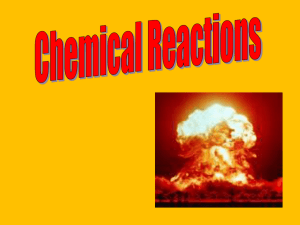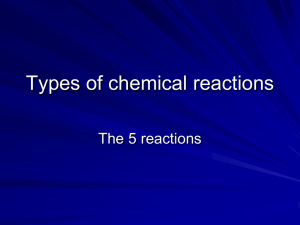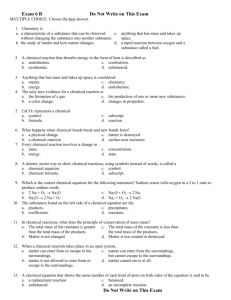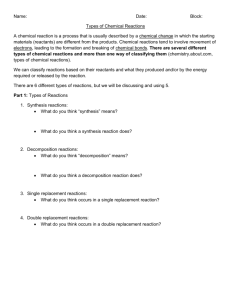Extra Credit Reaction types wkst
advertisement
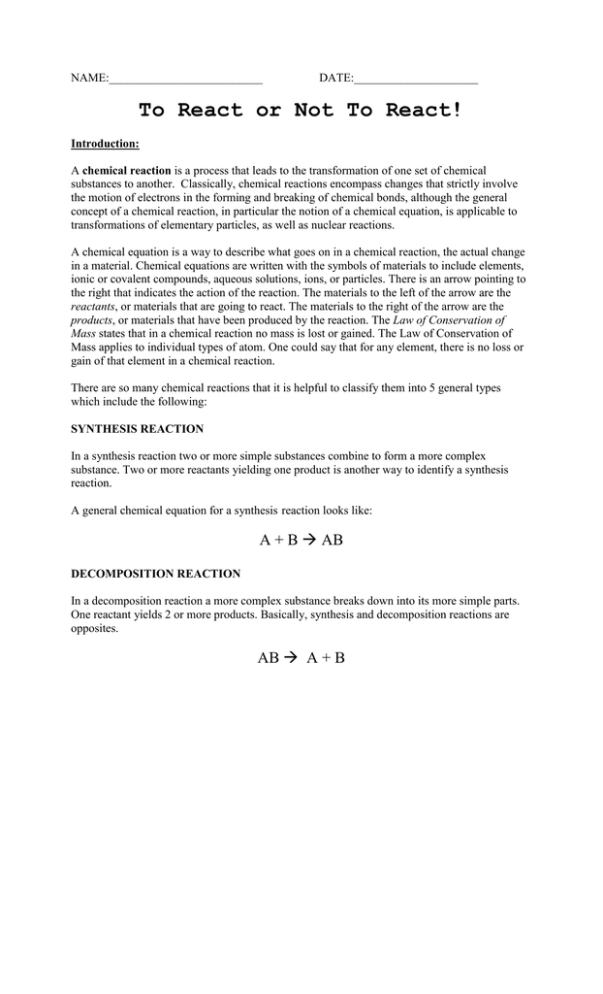
NAME:__________________________ DATE:_____________________ To React or Not To React! Introduction: A chemical reaction is a process that leads to the transformation of one set of chemical substances to another. Classically, chemical reactions encompass changes that strictly involve the motion of electrons in the forming and breaking of chemical bonds, although the general concept of a chemical reaction, in particular the notion of a chemical equation, is applicable to transformations of elementary particles, as well as nuclear reactions. A chemical equation is a way to describe what goes on in a chemical reaction, the actual change in a material. Chemical equations are written with the symbols of materials to include elements, ionic or covalent compounds, aqueous solutions, ions, or particles. There is an arrow pointing to the right that indicates the action of the reaction. The materials to the left of the arrow are the reactants, or materials that are going to react. The materials to the right of the arrow are the products, or materials that have been produced by the reaction. The Law of Conservation of Mass states that in a chemical reaction no mass is lost or gained. The Law of Conservation of Mass applies to individual types of atom. One could say that for any element, there is no loss or gain of that element in a chemical reaction. There are so many chemical reactions that it is helpful to classify them into 5 general types which include the following: SYNTHESIS REACTION In a synthesis reaction two or more simple substances combine to form a more complex substance. Two or more reactants yielding one product is another way to identify a synthesis reaction. A general chemical equation for a synthesis reaction looks like: A + B AB DECOMPOSITION REACTION In a decomposition reaction a more complex substance breaks down into its more simple parts. One reactant yields 2 or more products. Basically, synthesis and decomposition reactions are opposites. AB A + B SINGLE REPLACEMENT REACTION In a single replacement reaction a single uncombined element replaces another in a compound. Two reactants yield two products. A + BC AC + B DOUBLE REACTION REPLACEMENT In a double replacement reaction parts of two compounds switch places to form two new compounds. Two reactants yield two products. For example when silver nitrate combines with sodium chloride, two new compounds--silver chloride and sodium nitrate are formed because the sodium and silver switched places. The chemical equation for this double replacement reaction looks like: AB + CD AD + CB COMBUSTION A combustion reaction is when oxygen combines with another compound to form water and carbon dioxide. These reactions are exothermic, meaning they produce heat. An example of this kind of reaction is the burning of methane: CH4 (g) + 2 O2 (g) CO2 (g) + 2 H2O (g) Problems: Chemical reactions, also called chemical changes, are not limited to happening in a chemistry lab. Here are some examples of chemical reactions with the corresponding chemical equations. Complete, Identify and balance the type of chemical reaction. 1) A silver spoon tarnishes. The silver reacts with sulfur in the air to make silver sulfide, the black material we call tarnish. Ag + S Ag2S _______________ 2) An iron bar rusts. The iron reacts with oxygen in the air to make rust. Fe + O2 Fe2O3 _______________ Product name: ____________ 3) Propane in a gas grill burns. Propane combines with oxygen in the air to make carbon dioxide and water vapor. C3H8 + O2 CO2 + H2O ___________ 4) An antacid (calcium hydroxide) neutralizes stomach acid (hydrochloric acid). Ca(OH)2 + HCl CaCl2 + H2O ____________ 5) Glucose (simple sugar) ferments to ethyl alcohol and carbon dioxide. The sugar in grapes or from grain ferments with yeast to make the alcohol and carbon dioxide. The carbon dioxide is the gas that bubbles out of beer or Champaign. C6H12O6 C2H5OH + CO2 ____________ 6) NaOH + KNO3 _______ + _______ ______________ 7) Fe + NaBr --> _______ + _______ ______________ 4) CaSO4 + Mg(OH)2 --> _______ + _______ ______________ 5) NH4OH + HBr --> H2O + NH4Br ______________ 6) Pb + O2 --> PbO2 ______________ 7) Na2CO3 --> Na2O + CO2 ______________ 8) HNO3 N2O5 + H2O ______________ 9) CaCl2 + K2CO3 _______ + _______ 11) Cl2 + 12) KI _______ + _______ Fe2O3 + C 13) P + Cl2 CO2 + Fe ______________ ______________ ______________ PCl3 ______________ 14) H2O2 H2O + O2 ______________ 15) C6H6 + O2 _______ + _______ ______________ Questions: Based your answers to questions 1 and 2 on the following equation: K + S8 K2S 1) (1) (2) (3) (4) What type of reaction? Synthesis Decomposition Combustion Single Replacement 2) In terms of the number of atoms describe how this reaction obeys the law of conservation of mass. 3) In terms of elements describe how a chemical reaction differs from a nuclear reaction. Reflection: In your own words describe each type of reaction. Synthesis Decomposition Single Replacement Double Replacement
